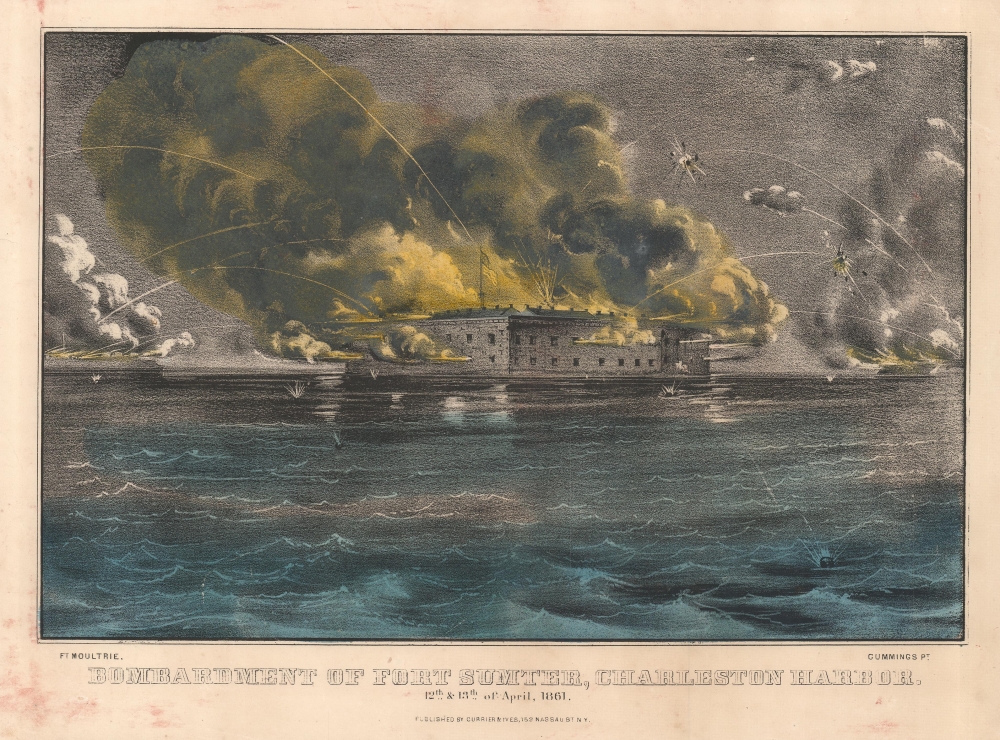This item has been sold, but you can get on the Waitlist to be notified if another example becomes available, or purchase a digital scan.
1861 Currier and Ives View of the Bombardment of Fort Sumter, South Carolina
FortSumter-currierives-1861
Title
1861 (undated) 8.75 x 11.75 in (22.225 x 29.845 cm)
Description
A Closer Look
Oriented towards the southeast, this view looks towards the Atlantic from Charleston Harbor, depicting the shelling of Ft. Sumter. The American flag stands intact at the center as shells (mostly incoming but some outgoing), smoke, and fire fill the sky. The locations of Ft. Moultrie (already abandoned by Union troops and occupied by Confederates) and Cummings Point are indicated in the bottom margin.The Battle of Fort Sumter
Taking place on April 12 and 13, 1861, in Charleston Harbor, South Carolina, the Battle of Fort Sumter marked the beginning of the American Civil War. The fort was held by Union forces but surrounded by Confederate troops who demanded its surrender. When the Union garrison refused to vacate, the Confederates began bombarding it. The Union garrison tenaciously defended the fort but eventually surrendered after 34 hours of bombardment (with more than 3,000 rounds fired by the Confederates) as they were running out of supplies and ammunition. Remarkably, the siege led to no casualties on either side, though two Union soldiers were killed in an accident resulting from a 100-gun salute during the surrender ceremony. The fall of Fort Sumter galvanized both the North and the South, leading to widespread mobilization and the escalation of hostilities, setting off the U.S. Civil War.Publication History and Census
This view was published by Currier and Ives in New York City. It is undated, but like most small-format Currier and Ives Civil War prints, it was issued in the immediate wake of events to capitalize on a news-hungry public. Another print of the same title was published around the same time, displaying a perspective from inside the fort. The University of South Carolina catalogs the two prints together (OCLC 881684360), while the present work is independently cataloged among the holdings of the Boston Public Library, American Antiquarian Society, and Boston Athenaeum (OCLC 57743860). Not listed in the OCLC are examples held by the Library of Congress and the Gilder Lehrman Institute of American History.CartographerS
Nathaniel Currier (March 27, 1813 - November 20, 1888) was an American lithographer best known as part of 'Currier and Ives'. Born in Roxbury, Massachusetts, Currier attended public schools until fifteen, when he apprenticed with the Boston lithographic firm of William and John Pendleton. The Pendletons were the first successful lithographers in the United States and were responsible for educating the next generation of lithographic printers. In 1833, Currier left the Pendleton's shop to work with M.E.D. Brown in Philadelphia. A year later, Currier moved to New York City, where he planned to start a business with John Pendleton. When Pendleton backed out, Currier found a new partner, founding 'Currier and Stodart', but the concern survived for just a year. Currier opened his own lithographic studio in 1835 as an eponymous sole-proprietorship. He initially printed the standard materials, including letterheads, sheet music, and handbills. Later in 1835, Currier began issuing current event imagery. Some of his news printers were issued in the New York Sun. By 1840, Currier had moved away from 'job printing' and further toward fine-print publishing. His Awful Conflagration of the Steam Boat 'Lexington', was published in the Sun that year, as well as being separately issued. James Ives (March 5, 1824 - January 3, 1895) began working under Currier in 1850 as a bookkeeper. Ives contributed greatly to the growth of the business, particularly as a manager, marketer, and businessman. Ives became a full partner in 1857, and the firm was renamed 'Currier and Ives'. Currier and Ives produced over 7,500 images and is best remembered for its popular art prints, particularly Christmas scenes and landscapes. They also produced banners, illustrations of current events, views, and historical scenes. Currier retired in 1880 and turned the business over to his son Edward. Currier married Eliza West Farnsworth in 1840, with whom he had one child Edward West Currier. Eliza died in 1843. Currier remarried to Lura Ormsbee in 1847. Other than being a lithographer, Currier also served as a volunteer New York City fireman during the 1850s, and he liked fast horses. More by this mapmaker...
James Merritt Ives (March 5, 1824 - January 3, 1895) was an American businessman, bookkeeper, and lithographer who oversaw the business side of the famed lithographic firm Currier and Ives. Born in New York City, Ives was a self-trained artist who began working at the age of twelve. He married Caroline Clark (1827 - 1896) on June 24, 1846, who was the sister-in-law of Nathaniel Currier's brother, Charles Currier. In 1852, Nathaniel Currier (March 27, 1813 - November 20, 1888) hired Ives as the bookkeeper for his firm N. Currier, Lithographer, on Charles's recommendation. Ives' talent for art and his knowledge of the artistic world soon became apparent to Currier, who valued his insights as well as the business acumen. Currier offered Ives a full partnership in 1857. They renamed the firm 'Currier and Ives' with Ives as the general manager. Ives began to play a role in selecting artists and prints to publish, and was responsible for pursuing publication of scenes of middle-class America that made the firm famous. After Ives died in 1895, his sons continued to work with Currier's son to manage the firm until it was liquidated in 1907. Learn More...

